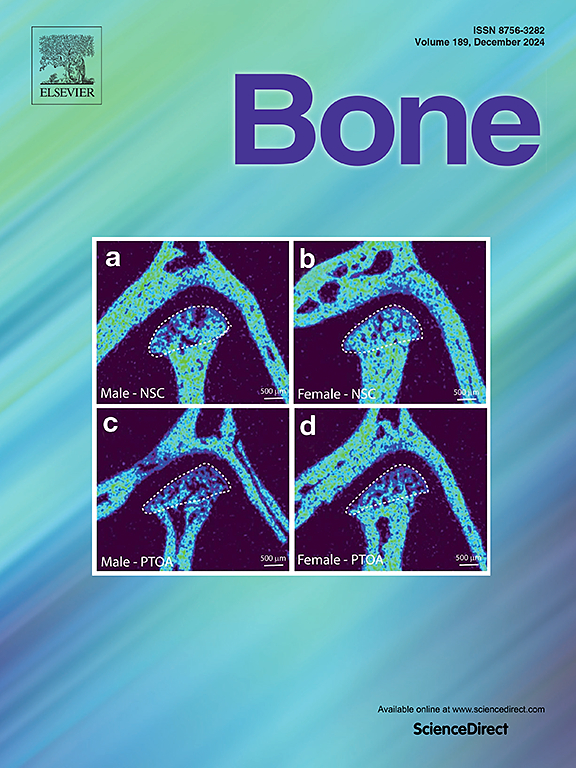Mild to moderate COPD, vitamin D deficiency, and longitudinal bone loss: the Multi-ethnic Study of Atherosclerosis
IF 3.5
2区 医学
Q2 ENDOCRINOLOGY & METABOLISM
引用次数: 0
Abstract
Objective
Despite the established association between chronic obstructive pulmonary disease (COPD) severity and risk of osteoporosis, even after accounting for the known shared confounding variables (e.g., age, smoking, history of exacerbations, steroid use), there is paucity of data on bone loss among mild to moderate COPD, which is more prevalent in the general population.
Methods
We conducted a longitudinal analysis using data from the Multi-Ethnic Study of Atherosclerosis. Participants with chest CT at Exam 5 (2010−2012) and Exam 6 (2016–2018) were included. Mild to moderate COPD was defined as forced expiratory volume in 1 s (FEV1) to forced vital capacity ratio of <0.70 and FEV1 of 50 % or higher. Vitamin D deficiency was defined as serum vitamin D < 20 ng/mL. We utilized a validated deep learning algorithm to perform automated multilevel segmentation of vertebral bodies (T1–T10) from chest CT and derive 3D volumetric thoracic vertebral BMD measurements at Exam 5 and 6.
Results
Of the 1226 participants, 173 had known mild to moderate COPD at baseline, while 1053 had no known COPD. After adjusting for age, race/ethnicity, sex, body mass index, bisphosphonate use, alcohol consumption, smoking, diabetes, physical activity, C-reactive protein and vitamin D deficiency, mild to moderate COPD was associated with faster decline in BMD (estimated difference, β = −0.38 mg/cm3/year; 95 % CI: −0.74, −0.02). A significant interaction between COPD and vitamin D deficiency (p = 0.001) prompted stratified analyses. Among participants with vitamin D deficiency (47 % of participants), COPD was associated with faster decline in BMD (−0.64 mg/cm3/year; 95 % CI: −1.17 to −0.12), whereas no significant association was observed among those with normal vitamin D in both crude and adjusted models.
Conclusions
Mild to moderate COPD is associated with longitudinal declines in vertebral BMD exclusively in participants with vitamin D deficiency over 6-year follow-up. Vitamin D deficiency may play a crucial role in bone loss among patients with mild to moderate COPD.
轻至中度COPD、维生素D缺乏和纵向骨质流失:MESA研究
目的:尽管慢性阻塞性肺疾病(COPD)严重程度与骨质疏松风险之间存在既定的关联,即使在考虑了已知的共同混杂变量(如年龄、吸烟、病情加重史、类固醇使用)后,仍缺乏轻至中度COPD中骨质流失的数据,而轻至中度COPD在普通人群中更为普遍。方法:我们使用来自动脉粥样硬化多民族研究的数据进行纵向分析。在检查5(2010-2012)和检查6(2016-2018)进行胸部CT检查的参与者被纳入。轻至中度COPD定义为用力呼气量为1 s (FEV1)与用力肺活量之比为1 / 50 %或更高。维生素D缺乏症被定义为血清维生素D 结果:在1226名参与者中,173名在基线时患有轻度至中度COPD,而1053名没有已知的COPD。在调整了年龄、种族/民族、性别、体重、指数、双膦酸盐使用、饮酒、吸烟、糖尿病、体力活动、c反应蛋白和维生素D缺乏等因素后,轻中度COPD与骨密度下降更快相关(估计差异,β = -0.38 g/cm3/年;95 % ci: -0.74, -0.02)。COPD与维生素D缺乏之间的显著相互作用(p = 0.001)提示分层分析。在维生素D缺乏的参与者中(47% %的参与者),COPD与骨密度下降更快相关(-0.64 g/cm3/年;95 % CI: -1.17至-0.12),而在粗模型和调整模型中,维生素D正常的人群中均未观察到显著关联。结论:轻度至中度COPD与椎体骨密度纵向下降相关,仅在维生素D缺乏症患者随访6年以上。维生素D缺乏可能在轻度至中度COPD患者的骨质流失中起关键作用。
本文章由计算机程序翻译,如有差异,请以英文原文为准。
求助全文
约1分钟内获得全文
求助全文
来源期刊

Bone
医学-内分泌学与代谢
CiteScore
8.90
自引率
4.90%
发文量
264
审稿时长
30 days
期刊介绍:
BONE is an interdisciplinary forum for the rapid publication of original articles and reviews on basic, translational, and clinical aspects of bone and mineral metabolism. The Journal also encourages submissions related to interactions of bone with other organ systems, including cartilage, endocrine, muscle, fat, neural, vascular, gastrointestinal, hematopoietic, and immune systems. Particular attention is placed on the application of experimental studies to clinical practice.
 求助内容:
求助内容: 应助结果提醒方式:
应助结果提醒方式:


